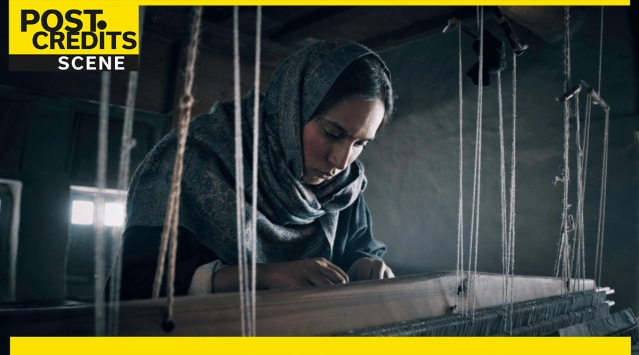Click here to follow Screen Digital on YouTube and stay updated with the latest from the world of cinema.
Maagh – The Winter Within: The finest Indian film of the year, the only alternative to all the Animals out there
Maagh - The Winter Within: Soulful, stirring, and simmering with scorched-earth rage, Aamir Bashir's sophomore feature is the best Indian film of the year.
 Zoya Hussain in a still from Maagh - The Winter Within.
Zoya Hussain in a still from Maagh - The Winter Within.There wasn’t a dry eye in the house as writer-director Aamir Bashir walked towards the stage following the Dharamshala International Film Festival screening of his new film, Maagh – The Winter Within. A modern-day fable about Kashmir, Maagh played to stunned silence for over an hour-and-a-half, before earning a most well-deserved standing ovation. Bashir, who previously directed the under-seen Harud (Autumn) more than a decade ago, spoke soberly about the never-ending winter that his home has been shrouded under. After answering a few questions, he took his leave, dismissing the moderator’s optimistic suggestion that his trilogy would remain incomplete without the obvious next instalment. He joked mirthlessly that he already has a title for his third film: Our Spring Will Never Come.
Soulful, stirring, and simmering with scorched-earth rage, The Winter Within is the best Indian film of the year, a stifled scream of a movie that is as breathtaking to behold as it is heart-wrenching to watch. It tells the story of a young woman named Nargis (a magnetic Zoya Hussain), who works as a house help in Srinagar and reports like clockwork at a local detention centre where she suspects her missing husband, Manzoor (Manzoor Ahmad Bhat), has been kept under suspicion of being a militant. Nargis is among the thousands of ‘half-widows’ of Kashmir, women who don’t know if their husbands are alive or not, cursed to spend their lives in an emotional limbo.
Also read – Shikara: The better film about the Kashmir conflict, but you chose to make the wrong one a hit
She makes ends meet by weaving shawls that she sells to a local businessman named Yaseen (Shabir Ahmad Lone) who secretly harbours feelings for her, but maintains a respectful distance. But when Nargis attracts unexpected attention for her determined quest to locate Manzoor, she is fired from her job and forced to return to her village home. There, as a member of a nomad community, she is further marginalised by her own. Bashir’s film calls into question the many atrocities that have been inflicted upon his people, but he doesn’t hesitate to offer internal critique about the corruption of the complacent and the the apathy of the elite.
 A still from The Winter Within.
A still from The Winter Within.
The early scenes are marked by a quiet oppression and the illusion of peace. Everyday realities are captured remarkably by co-writer and cinematographer Shanker Raman’s composed, Kiarostami-esque camera, which hovers with equal ease over the hills and valleys of Kashmir’s landscape and the expressive faces of its people. The paranoia, on the other hand, is built through stray shots of commandos, armed trucks passing in the background, and the sound of radio chatter. Music is used sparingly; the film’s searing emotion is conveyed mostly through a series of close-ups that are confrontational by design. In these 90 minutes, you will not be allowed to avert your eyes from this tragedy; you thought you were free, but complicity, the movie says, is its own form of capture.
Shortly after Nargis’ return to her village, and mere hours after Yaseen has made his feelings known, Manzoor shows up out of the blue, adding a new layer of complexity to her life. Clearly traumatised by his imprisonment, he is unable to eat or sleep. Instead, he spends his days and nights smoking endlessly near the window, framed in stunning tableaus once again designed to draw your attention to the horrors hidden beneath the beauty of this land. Bashir satirises how outsiders view the Valley in a shocking sequence towards the end, when Manzoor tries to rehabilitate himself by finding work in the tourism industry. Oh, the irony. It’s like the displaced Tibetan community in India having to sell Chinese food in order to make ends meet. Manzoor tugs entitled young couples across the snow, the rope wrapped around his neck like a noose. He is a mule. He is a servant. He is a dead man walking. The tourists — these are the kind of people who probably watched The Kashmir Files in theatres — scream at him to hurry up, to pull harder. They abused him when he chose violence, and they abuse him now, after his spirit and body have been systematically destroyed.
 A still from The Winter Within.
A still from The Winter Within.
But there’s hope yet for Nargis, or, at least that’s what we try to convince ourselves into believing. She represents both the harsh realities and poetic ideals of Kashmir. As the wife of a militant, her reputation has forever been stained. But she didn’t pick up arms like her husband, despite her desire for ‘azaadi’; she chose to preserve her identity through her art. Through the course of the film, Nargis crafts the most intricate shawl — her magnum opus; an ode to the resilience of an entire community, and a symbol of her silent protest. In many ways, Nargis is Bashir — a custodian of her culture, and a chronicler of its pain.
Read more – Pokhar Ke Dunu Paar movie review: Poetic and profound, the best Hindi film of the year
You become so familiar with the contours of her face over 90 minutes, it begins to have an oddly comforting affect. Which is why the final shot — one of the most haunting images in recent memory — will linger forever in my mind. Almost as an act of defiance, the camera detaches itself from its tripod and begins scanning the surroundings for some stability. It is as if the movie is finally shedding its own delusions. Hope is a pipe dream for some, regardless of whether they’re living in conflict zones or making films in an industry that actively seems to be averse to empathy. Those predisposed to bigotry will not be converted by this film’s beauty; it would be irrational to think otherwise, especially in an era where sensitivity is seen as something to snark at and ‘content’ is greenlit on the basis of whether it could make a good thumbnail or not. But by merely existing, The Winter Within can thaw the coldest hearts.
Post Credits Scene is a column in which we dissect new releases every week, with particular focus on context, craft, and characters. Because there’s always something to fixate about once the dust has settled.


Photos


- 01
- 02
- 03
- 04
- 05






























